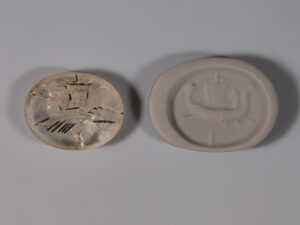In Ancient Roman society, jewellery was an essential accessory, providing the wearer with a public display of their wealth, social status, and identity. Gold and silver pieces were worn by the wealthier members of Roman society, while bronze and other metals provided a cheaper alternative for lower social classes. Roman jewellery at first followed the trends set by the Etruscans, employing the use of gold and glass beads. As the power and spread of the Roman Empire increased, jewellery designs became increasingly elaborate, utilising the many different materials, techniques, and styles found across the expanding empire, particularly from Greece, Egypt, North Africa, and the Orient. Earrings are known as one of the first forms of jewellery, found adorning both men and women as early as the Bronze Age. Pliny the Elder attested to the popularity of earrings, with pearl earrings being especially popular among women.
The term intaglio refers to a small image that has been engraved into a gemstone and usually set in a piece of jewellery, most commonly a ring. Such artistic form has its origin in Sumer in the 4th millennium BC, with the appearance of cylinder and stamp seals, whereby decorations and patterns were engraved into soft stones. Intaglios with fine detailing were highly desired with one reason being that the intricacy making wax seals difficult to forge. The earliest intaglios were produced by hand using simple iron tools along with abrasive emery powders. Common scenes used during the Roman period were animals, mythological creatures and portraits. During the Hellenistic period and the early Roman Empire, the art of intaglio reached its apogee, with there being a steady decline in craftsmanship in the late Imperial Rome, until a revival of interest with the Byzantine and during the Renaissance.
To discover more about Roman intaglios, please visit our relevant blog post: Engraved Gemstones in Ancient Rome.






















